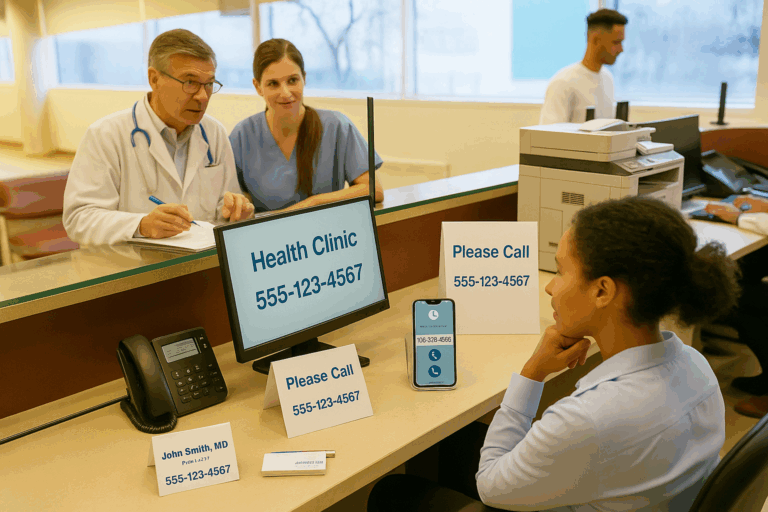Healthcare should focus on patients. However, more than half of patients report having had a negative healthcare experience, and over a third have avoided care altogether because of it. Patient-centered care is not merely an ideal; it is a necessity. One of its most overlooked drivers is simple: the effectiveness of our communication.
Identified by the National Academy of Medicine (NAM) as one of the six elements of high-quality healthcare, patient-centered care (PCC) encourages and empowers individuals to take a more active role in their care. Its primary goal is to improve health outcomes by informing and involving patients, enabling them to make informed decisions about their treatment and well-being.
As a form of personalized care, patient-centered care (PCC) emphasizes not only the physical and mental health of patients but also the emotional, financial, and social factors and values that influence their overall well-being. The Centers for Medicare & Medicaid Services (CMS) highlights that patient-centered care encompasses:
- Care that’s guided and informed by patients’ goals, preferences, and values
- Success measured by patient-reported outcomes
- Integrated and coordinated care across health systems, providers, and care settings
- Managing chronic and complex conditions
- Relationships built on trust and a commitment to long-term well-being
Unlocking Improved Outcomes: The Components and Benefits of Patient-Centered Care
“When patients don’t feel heard by their doctors, there’s an erosion of trust that can lead to serious health consequences—even if clinicians have their patients’ best interests in mind.”
Johns Hopkins Bloomberg School of Public Health
Active listening is a fundamental principle of PCC. However, it goes beyond that – true patient-centered care also encompasses empathy, emotional support, shared decision-making, family involvement, and timely access to information and providers. As a healthcare provider, it’s essential to be transparent with your patients, collaborate with them, and engage them in every stage of their care journey.
Achieving the four Ps of patient-centered care – predictive, preventive, personalized, and participatory – can lead to numerous benefits for your practice, including:
- More cost-effective healthcare delivery
- Reduced expenses
- Improved patient engagement and satisfaction
- Increased patient safety, better resource allocation
- Fewer unnecessary tests and procedures
- Enhanced provider reputation
- Higher morale and productivity among physicians and ancillary staff
Medical groups that prioritize patient-centered care achieve better outcomes. Patient-centered care (PCC) has also shown improvement in healthcare outcomes for chronic diseases, including depression and anxiety disorders, cardiovascular risk management, diabetes, and addictive behaviors.
Communication: The Key to Making PCC Work
Successful PCC doesn’t occur without another crucial component: communication. Effective communication in healthcare provides numerous benefits, ranging from improved staff teamwork and collaboration to fewer patient complaints, lower care costs, and reduced stress and burnout for clinicians.
Healthcare communication encompasses more than just answering patients’ questions or scheduling appointments. It serves as the foundation for trust, safety, and positive long-term outcomes. Patient-centered communication from healthcare providers correlates with improved emotional health for patients, and addressing patient inquiries is linked to better psychosocial adjustment over time.
As mentioned in a previous blog highlighting tips for designing a HIPAA-compliant phone system, research suggests strong relationships exist between a healthcare team member’s communication skills and a patient’s ability to follow medical recommendations, self-manage a chronic condition, and adopt preventive health behaviors. Healthcare providers delivering patient-centered care should enhance patient-provider relationships through clear communication, and a feature-rich voice over internet protocol (VoIP) phone system designed for physician practices effectively facilitates this.
Utilizing Technology to Enhance Provider-Patient Communication
Effective communication between you and your patients enhances their sense of control over their health, increases their understanding of symptoms and self-care, and aids in recognizing changes in their condition. When patients engage in their care, they can more effectively manage complex chronic conditions by comprehending and following their care plan.
Most patients prefer communication that centers on their needs and using convenient tools to interact with their providers.
According to a resource from the Commonwealth Fund, healthcare technology is a crucial aspect that providers should emphasize to promote patient-centered care. In addition to minimizing wasted time through operational efficiencies and recovering lost revenue by reducing patient no-shows, digital health tools that prioritize patient safety and privacy make healthcare more accessible and improve the overall patient experience.
These tools also create a more cohesive care delivery system, reducing fragmentation and enabling your team to track, follow up, and communicate with patients more effectively.
Digital health tools can enhance PCC models by offering access to continuously collected patient data. They also assist nursing teams in minimizing fragmented care and enabling processes to operate more cohesively.
Equipping your practice with a HIPAA-compliant communications platform provides access to numerous features that enhance patient-centered care (PCC). Unlike outdated communication technologies – many of which grow increasingly unreliable over a five- to ten-year period and hinder communication among your employees and patients outside the office – VoIP-powered phone systems create a positive first impression for your patients while alleviating the administrative burden on you and your staff.
The next step is to personalize that communication. At RingRx, we’ve developed a healthcare-specific business-class phone system that simplifies this process for you. Here are five features you can implement to customize your RingRx communications platform to meet your practice needs – whether you have just one office or multiple locations:
How RingRx Supports Patient-Centered Care: 5 Features That Make a Difference
1. Smarter On-Call Routing That Reduces After-Hours Headaches
Our HIPAA-compliant communications system includes a comprehensive calendar, profile, and management system that allows each on-call provider to create a personalized profile. This ensures proper call management, reducing administrative challenges and patient delays.
The RingRx platform allows you and your fellow practice physicians to set your preferred contact methods, whether your cell phone, a landline, or a mobile app extension. It directs patients calling after office hours to the appropriate on-call medical professional. It manages all on-call scheduling information directly within a single platform that is updated in real-time.
2. Secure Text Messaging That Patients Actually Want
Over 95 percent of patients prefer texting for healthcare communication. Beyond fostering patient engagement, using automated text messaging can boost patient loyalty and retention, improve brand awareness, and maintain your practice’s competitiveness.
With RingRx, you can personalize HIPAA-compliant automated text and voice reminders to alert patients about upcoming visits and preventive screening opportunities at regular intervals. Our VoIP phone system enables you to send text messages containing sensitive patient information to your patients and colleagues from your smartphone, all while keeping your personal phone number private.
3. Call Routing That Gets Patients to the Right Person, Fast
Patients do not want to wait for your practice to answer the phone or be placed on hold until the appropriate staff member becomes available to speak with them.
Call routing improves your practice’s communication flow by efficiently managing incoming calls. It ensures that patients can easily reach the right provider for their requests. Patients with urgent medical needs are quickly connected to live support staff, while those with routine questions are directed to the team member best suited to assist them.
4. Call Recording That Trains Staff and Improves Experience
Call recordings can be used by your practice or office managers to evaluate staff performance, especially for those team members who frequently interact with patients. If they notice that a staff member is not adhering to call-handling policies and other communication best practices, they can provide training, thereby enhancing staff accountability and productivity. This results in a higher level of patient care, not to mention increased patient satisfaction.
This feature allows you to record and store calls on your RingRx system, whether you use a desk phone, mobile app, softphone, or a combination of these. Nurses can utilize call recording to review patient calls and ensure that important information is effectively communicated to physicians and other staff members. Our call recording capability also enables you to record and store calls on our HIPAA-compliant servers, ensuring that protected health information (PHI) remains secure and providing additional protection for patients against data breaches and other cybercrime.
5. HD Voice That Makes Every Conversation Clearer
Could your practice benefit from outstanding sound quality, enhanced speech recognition, and improved connectivity? If so, our HD Voice feature is the ideal solution. With top-tier speech recognition and advanced HD Voice technology that minimizes background noise, this feature reduces communication misunderstandings, thereby increasing satisfaction for both you and your patients. Moreover, its poly acoustic clarity technology ensures smooth two-way conversations.
Better Communication, Better Care—With RingRx
RingRx’s customizable VoIP platform evolves with your practice. Whether you operate a solo office or manage multiple locations, we simplify aligning your communication with your patient-centered care goals.
Are you ready to enhance your patients’ experiences with care—from the initial call to the final follow-up? Schedule a demo today and see how RingRx supports better communication, care, and your practice.




